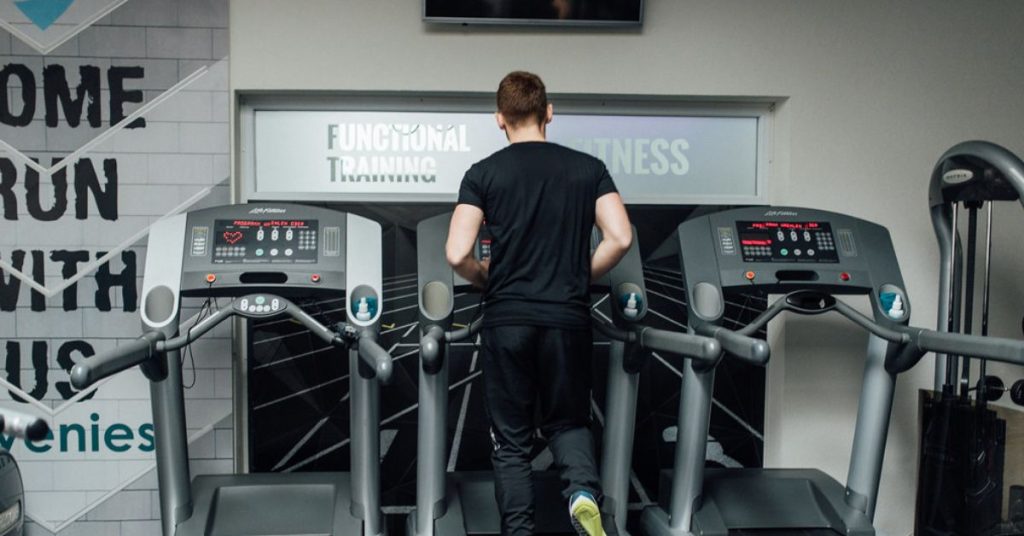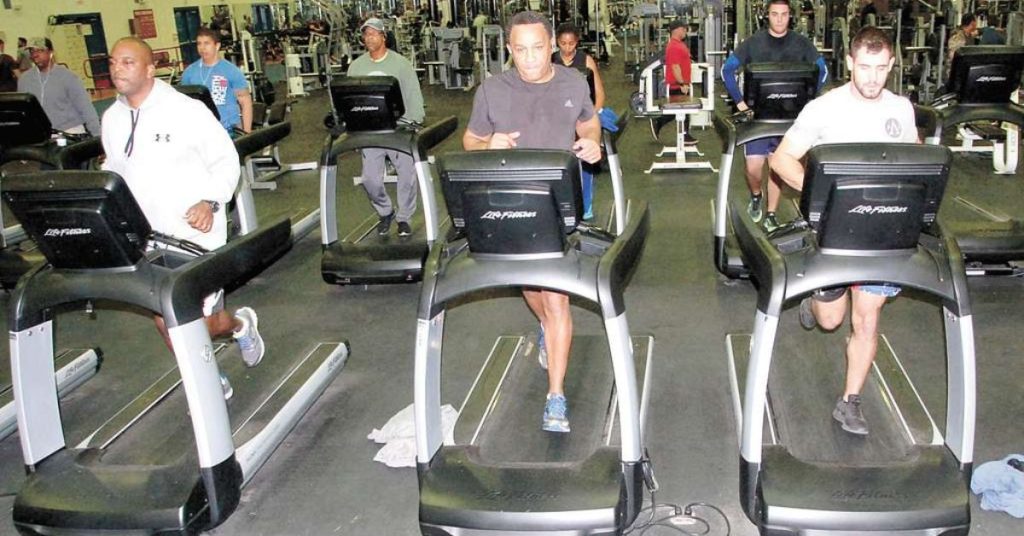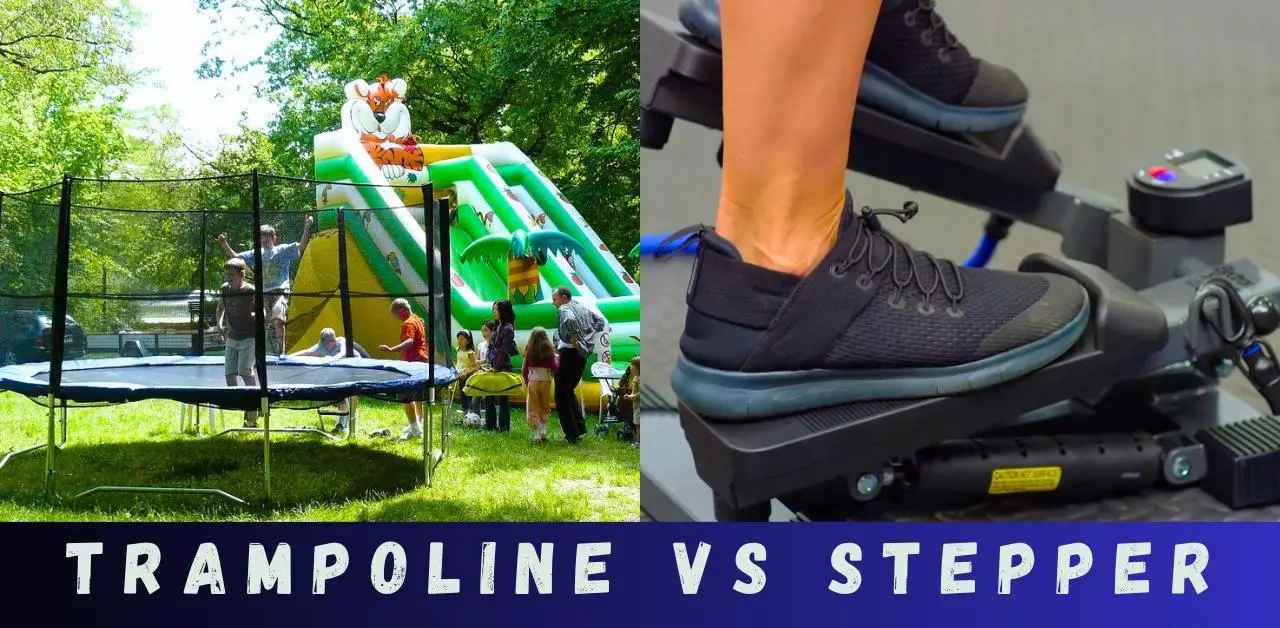Trampolines and steppers are both popular exercise equipment options that offer unique benefits and contribute to a healthy and active lifestyle.
Trampolines are known for their bouncy surface, which provides a fun and engaging way to work out, while steppers offer a low-impact, cardiovascular workout.
Trampolines, with their springy surface, allow users to perform a wide range of exercises that promote cardiovascular health, strength building, and improved balance.
Jumping on a trampoline engages multiple muscle groups and can increase coordination and agility. It also offers a low-impact option for those seeking to reduce joint stress.
On the other hand, steppers provide a convenient and compact option for aerobic exercise. With a stepping motion, steppers simulate climbing stairs, offering a targeted workout for the lower body.
They can be adjusted to vary the intensity of the exercise and are particularly beneficial for strengthening leg muscles and improving cardiovascular endurance.
Choosing between a trampoline and a stepper depends on personal preference, fitness goals, and individual circumstances. Both equipment options provide effective ways to stay active and fit.
Still, the decision should be based on factors such as space availability, desired workout intensity, and the specific muscle groups one wishes to target.
Trampoline vs stepper: Trampolines offer a fun, bouncy workout that engages multiple muscle groups, while steppers provide a low-impact option for aerobic exercise, focusing on strengthening the lower body.
Definition of Trampolines

Trampolines are recreational devices with a strong, flexible fabric sheet stretched tightly over a steel frame with coiled springs. They are designed to provide a surface for jumping and bouncing, allowing individuals to perform various exercises and activities while experiencing a unique sensation of weightlessness.
Trampolines come in different shapes and sizes, including round, rectangular, and oval, and can be used both indoors and outdoors.
Benefits of Trampoline Exercises
Trampoline exercises offer a wide range of physical and mental health benefits. Here are some key advantages:
Cardiovascular Health Improvement:
Jumping on a trampoline elevates heart rate and enhances cardiovascular endurance. The continuous bouncing motion provides an excellent cardiovascular workout, helping to strengthen the heart and improve overall cardiovascular health.
Increased Lymphatic Circulation:
Trampoline exercises facilitate lymphatic drainage, which is crucial to the body’s immune system. Jumping stimulates the lymphatic system, increasing the flow of lymph fluid and aiding in removing toxins, waste products, and cellular debris.
Improved Coordination and Balance:
Trampolining requires coordination and balance to maintain control while jumping and performing various movements. Regular trampoline exercises can enhance proprioception, spatial awareness, and motor skills, improving coordination and balance in daily activities.
Enhanced Bone Density:
The repetitive impact and gravitational forces experienced during trampoline exercises can help promote bone health and density. Jumping stimulates bone cells, encouraging the growth of stronger and denser bones, which is especially beneficial for individuals at risk of osteoporosis.
Stress Relief and Improved Mental Health:
Engaging in trampoline exercises can be a fun and exhilarating way to relieve stress and improve mental well-being. The release of endorphins during physical activity contributes to a positive mood and reduces feelings of anxiety and depression.
Safety Considerations and Precautions while Using Trampolines
While trampoline exercises offer numerous benefits, it’s important to prioritize safety to prevent injuries. Here are some safety considerations and precautions to keep in mind:
Proper Setup and Maintenance:
Ensure the trampoline is set up on a flat, level surface away from hazards such as trees, fences, or other structures. Regularly inspect the trampoline for any signs of wear and tear, including damaged springs, torn fabric, or loose connections, and perform necessary repairs or replacements.
Supervision for Children:

Adult supervision is crucial when children are using trampolines. Young children should always be closely monitored to prevent accidents or risky behavior.
Establish clear rules and guidelines for safe trampoline usage, including the number of users allowed at a time and appropriate jumping techniques.
Trampoline Safety Nets and Padding:
Installing safety nets around the trampoline can prevent users from falling off and reduce the risk of injury. Additionally, ensure the trampoline has adequate padding covering the springs and frame to minimize the chance of accidental contact and subsequent injuries.
Exercises and Techniques Suitable for Trampolines:
Engaging in appropriate exercises and techniques is essential for safe trampolining. Start with simple jumps and gradually progress to more advanced movements as skills and confidence improve.
Avoid risky stunts or acrobatics without proper training and supervision. It is also advisable to warm up and cool down before and after trampoline sessions to minimize the risk of muscle strains or sprains.
Definition of Steppers
Steppers are exercise machines designed to simulate the motion of climbing stairs or steps. They typically consist of two-foot pedals connected to a hydraulic or pneumatic mechanism that provides resistance.
Steppers can be found in various forms, including traditional stair climbers, pedal steppers, and mini steppers. They are compact and portable, making them suitable for home use or gym settings.
Benefits of Stepper Exercises
Engaging in stepper exercises offers many benefits for overall health and fitness. Here are some key advantages:
Cardiovascular Endurance Improvement:
Steppers provide an effective aerobic workout that boosts cardiovascular endurance. The repetitive stepping motion elevates heart rate and challenges the cardiovascular system, helping to strengthen the heart, increase lung capacity, and improve overall cardiovascular health.
Lower Body Strengthening:
Stepper exercises primarily target the lower body muscles, including the quadriceps, hamstrings, glutes, and calves. The resistance provided by the machine engages these muscles, promoting strength, endurance, and toning.
Regular stepper workouts can lead to stronger legs, improved balance, and better overall lower body functionality.
Calorie Burning and Weight Loss:
Stepper exercises are excellent for burning calories and supporting weight loss goals. The combination of cardiovascular intensity and muscle engagement helps to increase metabolic rate and energy expenditure. Stepping exercises can aid in shedding excess body fat and maintaining healthy body weight.
Joint and Bone Health Maintenance:
Steppers provide a low-impact workout option that reduces joint stress compared to running or jumping. The fluid stepping motion helps to strengthen the muscles around the joints and improve joint stability.
Furthermore, stepper exercises contribute to maintaining bone density, reducing the risk of osteoporosis, and promoting overall bone health.
Versatility and Ease of Use:
Steppers offer versatility in terms of workout intensity and customization. Resistance levels can be adjusted to accommodate various fitness levels, allowing beginners and advanced users to benefit from the machine.
Steppers are also user-friendly, with simple and intuitive movements that make them accessible to individuals of different ages and fitness backgrounds.
Safety Considerations and Precautions while Using Steppers
To ensure safe and effective stepper workouts, it is essential to consider the following safety considerations and precautions:
Proper Form and Technique:
Maintain proper posture throughout the exercise, keeping the back straight and shoulders relaxed. Avoid leaning too heavily on the handrails, which can diminish the workout intensity and compromise proper form. Engage the core muscles for stability and focus on stepping with controlled movements.
Adjusting Resistance Levels:
Select an appropriate resistance level that challenges the muscles without straining or causing excessive joint stress when using a stepper.
Gradually increase the resistance as strength and fitness levels improve. Listen to the body and make adjustments as necessary to prevent overexertion or injury.
Limitations for Individuals with Specific Health Conditions:
Individuals with certain health conditions, such as cardiovascular or joint problems, should consult a healthcare professional before using a stepper.
Some conditions may require modifications or precautions to ensure safe and appropriate exercise. Following medical advice and listening to the body’s limitations is important.
Warm-up and Cool-down Exercises:
Before engaging in stepper exercises, warming up the muscles and preparing the body for physical activity is essential. Perform dynamic stretches or light aerobic exercises to increase blood flow and flexibility.
Similarly, after the workout, incorporate static stretches to promote muscle recovery and prevent post-exercise soreness.
Trampolines vs Steppers: Expect Comparison
Trampolines and steppers are popular exercise equipment options with distinct characteristics and benefits. Here’s a comparison between trampolines and steppers across different factors:
Fitness Goals and Suitability
Trampolines: Trampolines offer a fun and effective way to achieve various fitness goals. They provide a full-body workout that can aid in weight loss, calorie burning, cardiovascular endurance, and muscle toning. Trampolines are also suitable for rehabilitation and low-impact exercise due to their cushioned surface.
Steppers: Steppers primarily target lower body muscles and are effective for cardiovascular workouts, muscle toning, and strengthening the legs, glutes, and core. They can help with weight loss and are generally suitable for low-impact exercise, making them beneficial for rehabilitation purposes.
Weight Loss and Calorie Burning:

Trampolines: Trampoline exercises involve dynamic, full-body movements that can burn many calories. The jumping and bouncing motions engage multiple muscle groups, promoting calorie expenditure and aiding in weight loss.
Steppers: Stepper exercises are also effective for calorie burning and weight loss. The continuous stepping motion elevates heart rate and increases metabolic rate, resulting in calorie expenditure. Steppers provide a controlled and consistent workout that can contribute to weight management goals.
Cardiovascular Endurance:
Trampolines: Trampoline exercises provide an excellent cardiovascular workout. The continuous jumping and bouncing movements elevate heart rate and challenge the cardiovascular system, improving endurance and cardiovascular health.
Steppers: Steppers offer a focused cardiovascular workout by simulating stair climbing. The repetitive stepping motion elevates heart rate, increasing cardiovascular endurance and strengthening the heart and lungs.
Muscle Toning and Strengthening:
Trampolines: Trampoline exercises engage various muscle groups, including the legs, core, and upper body. The jumping and bouncing movements help tone and strengthen muscles throughout the body, contributing to overall muscle development and toning.
Steppers: Steppers primarily target the lower body muscles, including the quadriceps, hamstrings, glutes, and calves. Stepper exercises are effective for lower body muscle toning and strengthening, promoting better balance and functionality.
Rehabilitation and Low-Impact Exercise:
Trampolines: Trampoline exercises offer a low-impact option that reduces joint stress. The cushioning effect of the trampoline mat makes it suitable for individuals with joint issues or those recovering from injuries. Trampolining can aid in rehabilitation and provide a gentle form of exercise.
Steppers: Steppers provide a low-impact, generally gentle workout on the joints. The controlled stepping motion reduces the risk of joint impact, making it suitable for individuals with joint concerns or those seeking a low-impact exercise option.
Impact on Joints and Injury Risk
When comparing trampolines and steppers, it is important to consider their impact on joints and the associated injury risks.
Trampolines:
Impact on Joints: Trampolines offer a relatively low-impact exercise option, as the mat absorbs a significant portion of the shock. However, improper landing or excessive jumping height can still pose a risk to joints, especially if performed incorrectly or excessively.
Injury Risk: The risk of injury on trampolines can be higher if proper safety precautions are not followed. Improper landings, collisions with other users, or attempting advanced acrobatic movements without proper training and supervision can lead to sprains, strains, or more severe injuries.
Steppers:

Impact on Joints: Steppers provide a low-impact exercise option that minimizes joint stress. The controlled stepping motion reduces joint impact compared to higher-impact activities such as running or jumping.
Injury Risk: While steppers offer a relatively low risk of injury, improper form or exceeding individual limitations can lead to muscle strains or joint discomfort. Maintaining proper technique, avoiding overexertion, and gradually increasing resistance levels are essential.
Variety and Diversity of Exercises
When comparing trampolines and steppers, the variety and diversity of exercises they offer differ to some extent.
Trampolines:
Trampolines offer various exercises and movements, including basic jumping, bouncing, twists, squats, and even aerobic routines. The versatility allows for creativity and diversity in workout routines, making it suitable for individuals who enjoy variety and prefer a more dynamic exercise experience.
Steppers:
Steppers primarily involve a repetitive stepping motion, limiting the exercise variety compared to trampolines. However, many stepper models come with additional features such as adjustable resistance levels, built-in workout programs, and arm exercise attachments, providing some level of exercise diversity.
Cost and Accessibility
When comparing trampolines and steppers, cost and accessibility are important factors to consider.
Trampolines:

Trampolines can vary significantly in cost, depending on the size, quality, and additional features. Prices range from affordable options for small indoor trampolines to more expensive options for larger, high-quality outdoor trampolines.
Additionally, outdoor trampolines may require additional costs for installation and maintenance.
Steppers:
Steppers generally offer a more affordable exercise equipment option compared to trampolines. The cost can vary based on the type of stepper and additional features, with mini steppers being the most cost-effective and larger stair climbers potentially being more expensive. Steppers also require minimal maintenance, resulting in lower long-term costs.
Space and Portability Considerations
When considering space and portability, trampolines and steppers have distinct characteristics.
Trampolines:
Trampolines, especially larger outdoor ones, require significant space for installation and safe usage. Adequate yard space or designated indoor areas are necessary to accommodate the size and safety perimeter of the trampoline. Additionally, outdoor trampolines may be less portable due to their size and weight.
Steppers:
Steppers are generally compact and lightweight, making them suitable for home use, even in limited spaces. Mini steppers, in particular, have a small footprint and can be easily stored in a closet or under a bed. Many models are also portable, allowing users to easily take them on trips or move them between rooms.
User Experience and Enjoyment
Certainly, let’s explore the “User Experience and Enjoyment” aspect comprehensively for both trampolines and steppers separately:
User Experience and Enjoyment on a Trampoline
Fun Factor:
Trampolines are renowned for their inherent fun factor. The sensation of bouncing on a trampoline is exhilarating and often described as joyful. It can evoke a sense of playfulness and excitement, making it an enjoyable fitness activity.
This aspect is not limited to any specific age group; both children and adults find bouncing on a tramp to be a delightful experience.
Potential for Family Use:
One of the notable advantages of trampolines is their suitability for family use. Families can engage in group trampoline activities, encouraging shared experiences and physical fitness together.
This not only promotes bonding but also instills healthy exercise habits in children from a young age. Trampolines provide an opportunity for families to spend quality time while staying active.
Variability:
Trampolines offer a wide range of exercise possibilities beyond simple bouncing. Various trampoline workouts, such as rebounder exercises or integrating movements from other fitness routines like Pilates, can add diversity to the fitness routine.
This variability keeps users engaged and motivated, preventing workout monotony.
User Experience and Enjoyment on a Stepper
Exercise Motivation:
Steppers can provide a strong sense of exercise motivation. With each step taken, individuals can feel a sense of accomplishment. This is particularly true for stepper machines with built-in tracking features, allowing users to monitor their progress and set achievable goals.
The ability to see improvements in terms of steps taken, distance covered, or calories burned can be highly motivating.
Long-term Engagement:
Steppers are known for their low-impact nature, which reduces discomfort and the risk of injuries during workouts.
This aspect is conducive to long-term engagement with stepper exercise routines. Individuals who experience less physical discomfort are more likely to stick to their workout regimen consistently. The potential for reduced impact-related pain can make stepper workouts sustainable over time.
Potential for Boredom:
However, it’s important to acknowledge that stepper workouts can become monotonous over time due to their repetitive motion.
To maintain long-term engagement, users may need to employ strategies such as varying workout routines, incorporating music or entertainment, or setting new challenges to prevent boredom and keep their exercise regimen exciting.
In conclusion, trampolines offer a fun and family-friendly fitness experience with a wide range of workout possibilities, while steppers provide exercise motivation and long-term engagement, albeit with a risk of potential monotony that can be mitigated with creative approaches.
The choice between the two ultimately depends on an individual’s preferences, goals, and the type of exercise experience they find most enjoyable.
FAQs About Trampoline vs Stepper:
Q1: Which is better for weight loss: a trampoline or a stepper?
Both trampolines and steppers can contribute to weight loss. Trampolines offer a dynamic, full-body workout that burns calories, while steppers provide a focused cardiovascular exercise primarily targeting the lower body. The choice depends on personal preference and the overall fitness routine.
Q2: Are trampolines or steppers better for cardiovascular endurance?
Both trampolines and steppers can improve cardiovascular endurance. Trampoline exercises elevate heart rate and challenge the cardiovascular system through continuous jumping, while steppers simulate stair climbing to increase heart rate and strengthen the heart and lungs.
Q3: Can trampolines or steppers help tone and strengthen muscles?
Trampolines engage various muscle groups, contributing to overall muscle development and toning. Steppers primarily target the lower body muscles, such as the quadriceps, hamstrings, glutes, and calves, improving strength and tone in that area.
Q4: Which is safer for joints: trampolines or steppers?
Trampolines offer a relatively low-impact exercise option, as the mat absorbs a significant portion of the shock. However, improper landing or excessive jumping height can still pose a risk to joints.
Steppers provide a controlled stepping motion with reduced joint impact compared to higher-impact activities. Both options have safety considerations and should be used properly and cautiously.
Q5: Can trampolines or steppers be used for rehabilitation or low-impact exercise?
Trampolines can be a suitable option for low-impact exercise and rehabilitation due to their cushioning effect, which reduces joint stress. Steppers also provide a low-impact workout that is generally gentle on the joints. However, it’s important to consult with a healthcare professional for specific rehabilitation needs or limitations.
Q6: Are trampolines or steppers more versatile in terms of exercise options?
Trampolines offer a wide range of exercises and movements, including jumping, bouncing, twists, squats, and aerobic routines, providing greater exercise variety.
Steppers primarily involve a repetitive stepping motion, but some models offer adjustable resistance levels and additional features to increase exercise diversity.
Q7: Which is more cost-effective: a trampoline or a stepper?
Steppers generally offer a more affordable exercise equipment option compared to trampolines. The cost of trampolines can vary depending on the size, quality, and additional features. Additionally, outdoor trampolines may require additional costs for installation and maintenance.
Conclusion
In conclusion, trampolines and steppers are effective exercise equipment options offering unique benefits and considerations.
Trampolines provide a fun and engaging way to improve cardiovascular health, enhance lymphatic circulation, boost coordination and balance, increase bone density, and relieve stress.
However, proper setup and maintenance, supervision for children, and the use of safety nets and padding are essential to ensure safe usage. Trampolines offer a wide range of exercises suitable for different fitness levels.
On the other hand, steppers improve cardiovascular endurance, strengthen the lower body muscles, burn calories, and maintain joint and bone health. They are versatile and easy to use, with adjustable resistance levels.
Maintaining proper form and technique is important, considering limitations for individuals with specific health conditions and incorporating warm-up and cool-down exercises when using steppers.
When comparing trampolines and steppers, fitness goals and suitability vary. Trampolines are well-suited for weight loss and calorie burning, cardiovascular endurance, muscle toning, and low-impact exercise.
At the same time, steppers excel in cardiovascular endurance, lower body strengthening, weight loss, and joint health. Factors such as impact on joints, variety of exercises, cost, accessibility, and space/portability considerations also differ between the two.
Ultimately, the choice between trampolines and steppers depends on individual preferences, fitness goals, and safety considerations, allowing individuals to select the equipment that best aligns with their needs and preferences.
We hope that after reading this detailed guide comparing trampolines and steppers, you now have a good understanding of their differences and benefits. If you have any questions, please don’t hesitate to ask in the comments below!

